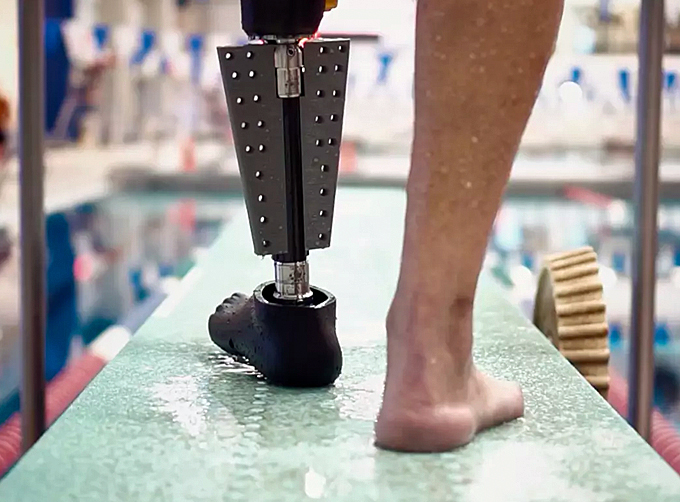Northwell Health has undertaken a new study to produce and commercialize its prosthetic swim leg, offering hope for the estimated 1.9 million Americans who have lost a limb to resume a more-active lifestyle.
The results of the study testing the ‘The FIN’ will aid in a future application to the US Food & Drug Administration (FDA), with the goal of partnering with the US Department of Veterans Affairs (VA), to make this life-changing prosthetic more widely available.
(See how a veteran and a 3D printer helped Northwell Health reimagine the possibilities of prosthetics. Courtesy of Northwell Health and YouTube. Posted on Mar 30, 2017.)
‘The Fin’ is the first 3D-printed, prosthetic leg attachment to give amputee swimmers the ability to navigate from land to the water and back without having to switch prosthetics.
The study seeks to gather data from up to 10 participants about the ease and efficiency of using ‘The Fin’ in the water.

“We made something that didn’t exist yet and solved a specific problem in a very spectacular way,” said Northwell Health researcher Todd Goldstein, PhD, who designed and developed the new amphibious prosthetic.
“My hope is that this device creates unforeseen opportunities for amputees everywhere.”
“This study is the first step in making this innovative prosthetic available to the millions of amputees looking to return to the water.”
For one of the study participants, 28-year-old U.S. Marine veteran Kevin Vaughan of Merrick, NY, ‘the Fin’ offers the hope of allowing him to continue his almost-daily swims in his backyard pool with ease.
Mr. Vaughan lost his leg in 2011 when a bomb attack in Afghanistan forced doctors to amputate his leg below the knee.
“Before the Marine Corps, I grew up at the beach and the pool, and that was hindered after my service,” he said.
“Now I can use this prosthetic to return to something I love to do, which is go the beach and swim.”
(See how a veteran and a 3D printer helped Northwell Health reimagine the possibilities of prosthetics. Courtesy of Northwell Health and YouTube. Posted on Sep 25, 2017.)
How do 3D printers work?
3D printers create solid objects by building up thin layers of material (such as different types of plastic); think of a normal printer printing a “stack” of paper but in a predefined shape—it can be solid or hollow, and sometimes needs support scaffolding to hold up pieces of the print when printing.

What materials are used in 3D printing?
There are many different kinds of materials and technologies used in 3D printing, which include:
- Plastic — uses a nozzle like a glue gun to melt plastic into thin filaments that are layered (aka thermoplastic extrusion, fused deposition)
- Binder jetting — uses a bed of plaster powder where an inket-style print head lays down binding solution (similar to superglue); alternates layers of powder and binder
- Metal — many ways to use different metals, can use heat, lasers, electron beams
- Stereolithography — uses resin that is layered and cured by lasers or lights
(See the ever-evolving field of 3D printing and its impact on health care. Courtesy of Northwell Health and YouTube. Posted on Apr 10, 2017.)
For 47-year-old Seamus Doherty of Manhattan, he said he hopes The FIN would mean spending more time with his active seven-year old son Seamus, who loves the water.
Mr. Doherty, a commanding officer of a detective squad in Brooklyn, lost his leg after a hit-and-run motorcycle accident nearly took his life.
“This prosthetic is the answer to my prayers in being able to spend more time with Seamus at the beach and truly being free to come and go in and out of the water,” he said.

The development of this pioneering, amphibious prosthetic was spearheaded by Northwell Ventures, which evaluates, develops and commercializes ideas that originate with the organization’s physicians, researchers and other employees.
‘The Fin’ was designed and printed by Northwell Health’s 3D printing experts, working in collaboration with a Long Island-based firm, Eschen Prosthetic and Orthotic Laboratories, a prosthetic design firm headquartered in Hicksville.
“For amputees with a passion for swimming, there was no device out there that was truly amphibious and allowed them to really swim,” said Thomas Thornton, senior vice president of Northwell Ventures.
“We hope to develop other customized solutions that will enable the estimated 1.9 million people who have lost a limb nationwide — a number that is expected to double by 2050 — to resume active lifestyles.”
The study underscores Northwell’s commitment to veterans and other patients to not only provide care, but to also push forward innovation.
To pre-order ‘The Fin’ or to learn more about Northwell’s automated 3D printing lab and how it is creating state-of-the-art, personalized treatments for patients, please visit https://www.northwell.edu/3d-design-innovation
Learn More…
(Learn More. Hear about the work done by Todd Goldstein, who recently received his PhD at the Hofstra North Shore-LIJ School of Medicine, while working on 3D Bioprinting at the Feinstein Institute for Medical Research. Courtesy of Feinstein Institute and YouTube. Posted on Oct 14, 2016.)

















